Bugs, drugs and electric venom: is this the most deadly library in the world?
The devil arrived at Andrew Walker’s laboratory in a cardboard box. Its fluorescent green body, covered in a thicket of menacing spikes, was adorned at both ends with a pair of black horns.
For residents of north-east Queensland, this devil – scientific name Comana monomorpha – is known as the electric caterpillar. Its sting, typically received while tending to lilly-pillies in the garden, is exceptionally painful.
The venom causes a nasty welt and a considerable rash that can last for a week. It’s so bad that some victims have spent a night in an emergency department. Health professionals treating afflicted people were seeing swelling, blood-filled boils and welts – but they could find nothing to help ease the pain.
According to one poster to a Townsville community group on Facebook, this “feels like the seven rings of hell”.
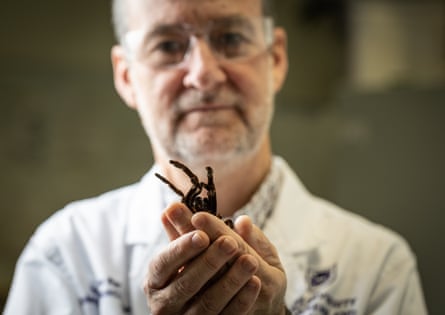
But where unlucky gardeners see an enemy, Walker sees a potential ally. “Caterpillars are my favourite venomous animal at the moment,” he says.
Walker, a molecular entomologist at the University of Queensland’s Institute for Molecular Bioscience, has characterised the venoms of some of the world’s least-studied venomous animals, including centipedes, assassin bugs and several caterpillars.
Alongside Glenn King, an affable biochemist who leads the Institute’s “bugs and drugs” group, and a former colleague, Volker Herzig, the group has collected venom from more than 500 species, building an unrivalled collection of animal toxins.
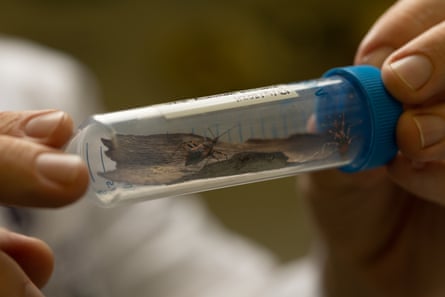
“This is by far the biggest invertebrate venom library in the world – probably the biggest venom library in the world,” King says.
Given that it includes venoms from Australian tarantulas, a Brazilian caterpillar and the lethal funnel-web spider, it might even be considered the most deadly library in the world. But researchers like King and Walker aren’t interested in venoms’ ability to kill.
They want to use it to heal.
Venom is, in the simplest terms, a toxin delivered by one animal into another. But that definition diminishes toxins’ complexity – they are composed of rich cocktails of molecules. More than 200,000 species on Earth are venomous and each have evolved their own set of biological weaponry to help them kill prey or, as with the caterpillar, defend against it.
-
Sign up for a weekly email featuring our best reads
Studying the molecules that make up venom, scientists have been able to develop compounds that can relieve chronicpain, treat diabetes and create eco-friendly insecticides. So far six venom-derived therapeutics have been approved for use in humans.
Many venoms are adept at disrupting a piece of mammalian cellular machinery known as an ion channel. These channels are used for everything from breathing to muscle contraction and neural signalling.

Scientists like King and Walker use that quirk of nature to their advantage: By identifying key molecules in venom that interact with ion channels, they hope to uncover molecules that can target those channels, ultimately leading to the creation of targeted therapeutics.
A venom library supercharges this process, allowing researchers to screen hundreds of venoms at once and rapidly identify promising candidate molecules.
“We can apply [the library] to virtually any human disorder where we think an ion channel might be involved in the disease,” King says.
On a warm Brisbane morning in early April, Walker leads me through doubled locked doors to the institute’s insectary. There are signs on the walls outside about the dangers that could be lurking within; chief among the threats is the funnel-web.
Inside the space is not much larger than an apartment bedroom. The sterile white and windowless laboratory is punctuated by three large grey cabinets – the kind you might find at a large hardware store. Walker opens one, plucks out a plastic lunchbox and lifts the lid.
It’s not a funnel-web, to my relief. It’s Hector, the institute’s “media-trained” rainforest scorpion. Walker places it in my hands.
after newsletter promotion
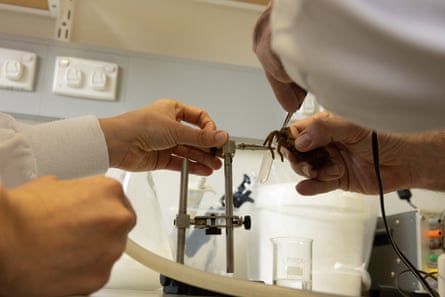

To date, snakes have provided the most useful venoms for human drugs and therapies. Scorpions, like Hector, and spiders – which belong to the same class of animals – have long provided useful insights into venom, though no therapeutic compounds have been developed from them. The bugs and drugs group hopes to change that.
Using the venom library, the University of Queensland team, along with scientists from Monash University, have characterised the venom of a subspecies of funnel-web spider, discovering a peptide with potent physiological effects. Known as Hi1a, the tiny protein blocks a signalling pathway that orders cells to die when there’s a lack of oxygen. When given to patients who have suffered a heart attack or stroke, Hi1a could protect against extensive, lasting damage.
In animal models, studies have suggested the molecule may have protective effects against heart attack. It’s slated for preliminary human clinical trials in 2025.
As Hector rests calmly in my palm, Walker explains how his research has seen him move from neuroscience to studying silk proteins, and now to looking beyond scorpions and spiders.
“My idea was that, if you went to a different group of animals that had evolved venom independently, then you would start to see very different types of molecules,” he says.
Walker’s work with caterpillars is at a much earlier stage than the group’s funnel-web studies. Spiders are generally much larger than caterpillars and produce a lot more venom. The typical yield after milking a spider can be measured in microlitres. Venom yield in caterpillars is measured in nanolitres – amounts barely perceptible in a test tube.
King says it would have been impossible to study this amount of venom just 20 years ago but technological advances have enabled researchers to identify peptides from minuscule volumes. This has resulted in a few surprises.
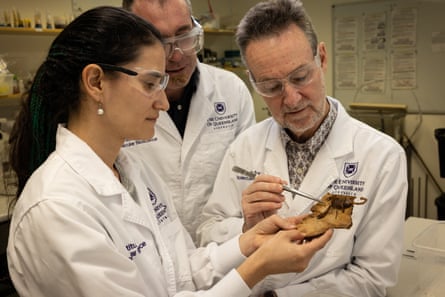
For one, it was predicted that caterpillar venoms would contain simple peptides and proteins – much like bee venoms – because they’re used purely for defence. But Walker’s studies have shown that the molecules produced in caterpillar toxins are much more complex than expected.
In the case of the asp caterpillar, a moth larva which looks like a toupee, Walker found evidence that it may have acquired its toxic capabilities via gene transfer with bacteria many millions of years ago. In research yet to be published, he suggests that the electric caterpillar may have undergone a similar process.
Both species contain venoms rich in molecules which are able to punch holes in a cell membrane, causing an attacking animal to feel pain.
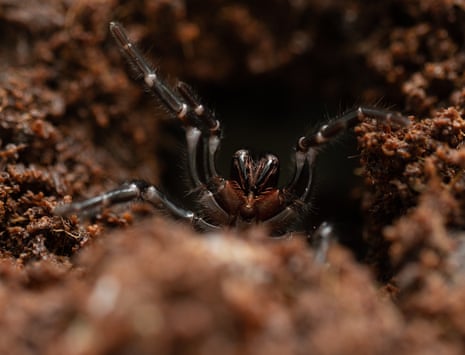
These proteins present a possible path to new insecticides and therapeutics. Similar molecules have been used to protect crops from pests and some are being developed as a way of delivering drugs into cells. The electric caterpillar is unlikely to yield such impact, Walker stresses, but there are immediate benefits of understanding what makes up its venom – especially if you’re a resident of north-east Queensland.
Electric caterpillar envenomation has been notoriously difficult to treat. Ice packs don’t seem to work. An insect bite gel? Forget about it. Vinegar does nothing. Aspirin and paracetamol don’t ease the pain.
Later in the afternoon of my visit, when I’m meeting King and Walker at the university cafe to talk about caterpillars, they devise a potential solution in real time. King notes that pain from jellyfish stings can be alleviated by heat and Walker’s work has shown that peptides in asp caterpillar venom break down at higher temperatures. The electric caterpillar is similar, so they reason that a heat pack might be the best course of action for afflicted patients.
Walker doesn’t seem totally convinced but resolves to email a health worker in north-east Queensland who has been looking for answers. Perhaps he has finally found one.
Source: theguardian.com


